Three's a Trend: Second, Fourth and Ninth Circuits Uphold Broad "Related Claims" Language
February 23, 2016 —
Greg Steinberg – White and Williams LLPThe hallmark of a claims-made insurance policy is that the policy only provides coverage for claims that are “first made” during the policy period. As noted by the Texas Supreme Court, “for the insurer, the inherent benefit of a claims-made policy is the insurer's ability to close its books on a policy at its expiration and thus to attain a level of predictability unattainable under standard occurrence policies.”[1]
To ensure this “level of predictability,” claims-made insurance policies contain provisions stating that all “Related Claims” will be treated as a single claim deemed first made at the time the earliest of such claims was made. The “Related Claims” provision is an issue that comes up time and again – claims can span years, especially in the context of regulatory investigations, which often culminate in enforcement proceedings and litigation. This inevitably leads to disputes regarding whether later claims can be related back to the earlier claim, an issue that becomes even thornier when different insurers participate on different policy years.
Over time, case law on “Related Claims” has been mixed and somewhat inconsistent, with each case tending to hinge on its own unique set of facts, making it difficult to identify a clear standard for determining whether claims are related. However, three recent decisions out of the Second, Fourth and Ninth Circuits show that courts are increasingly deferring to the plain language of the policy and applying these provisions broadly.
Read the court decisionRead the full story...Reprinted courtesy of
Greg Steinberg, White and Williams LLPMr. Steinberg may be contacted at
steinbergg@whiteandwilliams.com
Texas Plans a Texas-Sized Response to Rising Seas
June 27, 2022 —
Francis Wilkinson - BloombergIn coastal Texas and many other places, walled cities are making a comeback. It’s quite a turnabout, as the efficacy of defensive walls had declined precipitously since the age of the long bow. Barbarians still menace, of course. But the rekindled enthusiasm for defensive walls is a response to a different kind of threat.
San Francisco is contemplating a huge tidal wall across its bay to fend off sea rise and the attendant dousing of some of the world’s most expensive real estate. Miami is weighing the damage a sea wall would do to tourist vistas against the damage a rising sea might do absent a wall. New Orleans, after $14 billion in levee construction, is an armored metropolis. Norfolk, Virginia, another low-lying city exposed to a surging sea, is spending a few hundred million federal dollars on a downtown sea wall. New York City, which has flooded in two devastating storms so far this century, is building a $1.45 billion series of walls, floodgates and underground drainage, a modest down payment on the city’s defense against rising tides and storm surge.
Read the court decisionRead the full story...Reprinted courtesy of
Francis Wilkinson, Bloomberg
Fracking Fears Grow as Oklahoma Hit by More Earthquakes Than California
July 09, 2014 —
Zain Shauk – BloombergSquinting into a laptop perched on the back of his pickup, Austin Holland searches for a signal from a coffee-can-sized sensor buried under the grassy prairie.
Holland, Oklahoma’s seismology chief, is determined to find the cause of an unprecedented earthquake epidemic in the state. And he suspects pumping wastewater from oil and gas drilling back into the Earth has a lot to do with it.
“If my research takes me to the point where we determine the safest thing to do is to shut down injection -- and consequently production -- in large portions of the state, then that’s what we have to do,” Holland said. “That’s for the politicians and the regulators to work out.”
So far this year, Oklahoma has had more than twice the number of earthquakes as California, making it the most seismically active state in the continental U.S. As recently as 2003, Oklahoma was ranked 17th for earthquakes. That shift has given rise to concern among communities and environmentalists that injecting vast amounts of wastewater back into the ground is contributing to the rise in Oklahoma’s quakes. The state pumps about 350,000 barrels of oil a day, making it the fifth largest producer in the U.S.
Read the court decisionRead the full story...Reprinted courtesy of
Zain Shauk, BloombergMr. Shauk may be contacted at
zshauk@bloomberg.net
Subcontractor Allowed to Sue Designer for Negligence: California Courts Chip Away at the Economic Loss Doctrine (Independent Duty Rule)
August 30, 2017 —
John P. Ahlers - Ahlers & Cressman PLLCAn architect may have to pay over $1 million to a subcontractor who was contractually obligated to rely on the designer’s plans – even though the architect was not a party to the contract.[1] That was the ruling in U.S. f/u/b/o Penn Air Control, Inc. v. Bilbro Constr. Co., Inc.[2]
The dispute involved a $7.3 million design-build contract award to Bilbro Construction (“Bilbro”) to renovate a facility for the Naval Facilities Engineering Command in Monterey, California. Bilbro hired an architect (“FPBA”) to serve as the designer of record and provide all the architectural design services. FPBA’s design team included an acoustical sub-consultant (Sparling). The general contractor (design builder) also retained Alpha Mechanical (Alpha) as the mechanical electrical and plumbing (“MEP”) design/build subcontractor. Alpha, in turn, subcontracted the MEP design to Shadpour Consulting Engineers. During the design phase of this project, Alpha’s MEP design was reviewed by FPBA, Bilbro, and Sparling at the 35, 75, and 100 percent design completion levels. Alpha demonstrated that it regularly received direct communications during design development from Sparling and FPBA, including comments, changes, and revisions. One example Alpha cited was it raised some concerns about anticipated noise level in eight rooms. Sparling made several recommendations to Alpha and Shadpour that were implemented.
Read the court decisionRead the full story...Reprinted courtesy of
John P. Ahlers, Ahlers & Cressman PLLCMr. Ahlers may be contacted at
jahlers@ac-lawyers.com
Construction Termination Issues Part 6: This is the End (Tips for The Design Professional)
September 25, 2023 —
Melissa Dewey Brumback - Construction Law in North CarolinaWhether your role is in helping analyze the contractor’s work on the project to certify a
contractor’s termination for cause, or you are
being shown the door yourself, and everything in between, termination is a subject that is ripe with potential problems.
Consider these summary tips as part of your practice, every time the termination idea arises:
- Remember that you are the neutral and must be impartial between Owner and Contractor
- After you have made a fair decision, document your decision to the Owner and Contractor
- Provide options less nuclear for Owners– stop work; removing scopes of work; etc.
Read the court decisionRead the full story...Reprinted courtesy of
Melissa Dewey Brumback, Ragsdale LiggettMs. Brumback may be contacted at
mbrumback@rl-law.com
20 Years of BHA at West Coast Casualty's CD Seminar: Chronicling BHA's Innovative Exhibits
May 03, 2018 —
Beverley BevenFlorez-CDJ STAFFThe Bert L. Howe & Associates, Inc., (BHA) exhibit has been a fixture at West Coast Casualty's Construction Defect Seminar since the mid-1990's. Through the years, BHA has updated their display, but no matter what year, you could count on the BHA exhibit to provide a not-to-be-missed experience.
2008-BHA's sleek, rear projection display includes a screen that promotes the firm's capabilities that can be seen throughout the exhibit hall. This would be one of many innovations BHA has brought to the West Coast Casualty seminar.
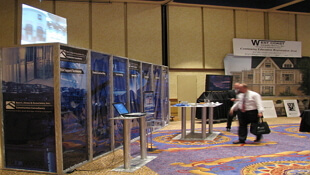
2009-With the success of the rear screen projection, BHA adds additional monitors to provide attendees with more information about BHA.
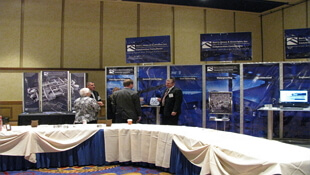
2010-BHA adds an interpretive professional development exhibit targeted to Building Envelope issues allowing adjusters and other non-construction professionals hands on access to the systems and components at the heart of many related such claims.



2011-BHA's Swing for Charity challenge is born.

2012-Always innovating, BHA expands its rear projection and professional development offerings to West Coast attendees.

2013-BHA showcases additional capabilities with a twenty-four foot, custom, convex, immersive video experience.

2014-BHA adds an iPhone display to give a hands-on demonstration of their data collection methods.
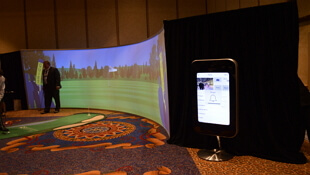
2015-BHA's twenty-four foot , custom, convex, immersive video experience was elevated with two additional rear projection screens, reflecting BHA's newest capabilities and services.

2016-BHA dazzles attendees with their new exhibit comprised of more than 15 integrated, high definition, LCD displays. iPads are stationed on tables to conveniently demonstrate BHA's data collection processes.
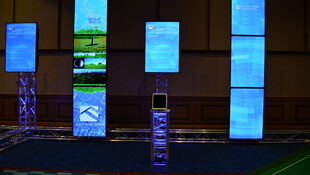
2017-BHA's Swing for Charity Golf Challenge raised $2,225.00 for the National Coalition for Homeless Veterans and $1,900 for Final Salute.
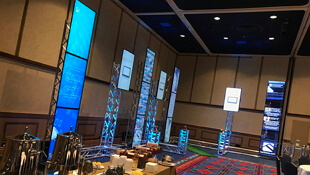
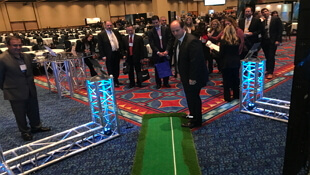
Read the court decisionRead the full story...Reprinted courtesy of
New York Public Library’s “Most Comprehensive Renovation” In Its History
May 13, 2014 —
Beverley BevenFlorez-CDJ STAFFManhattan’s New York Public Library’s renovation plans have been revised after being “the subject of at least three lawsuits and repeated protests by academics, activists, writers and historians,” according to Construction Digital. The previous $300 million plan by Foster & Partners would have required the circulation collections to be relocated during the renovation process. Now, that plan has been abandoned for one that New York Public Library President Anthony Marx calls “the most comprehensive renovation in its history.”
“Instead of removing the central stacks and placing the Mid-Manhattan Library in that space, we are proposing to renovate Mid-Manhattan Library at its current site,” Marx told Construction Digital. “This renovation will add much-needed computer labs and an adult education center, and an inspiring, comfortable space for browsing our largest circulating collection.”
Read the court decisionRead the full story...Reprinted courtesy of
Insurance Law Client Alert: California FAIR Plan Limited to Coverage Provided by Statutory Fire Insurance Policy
February 07, 2014 —
Valerie A. Moore and Chris Kendrick - Haight Brown & Bonesteel, LLPIn St. Cyr v. California Fair Plan Association (No. B243159, filed 1/31/14), a California appeals court held that the state's high risk property insurance plan is not obligated to provide any greater coverage than that mandated for the state's statutory fire insurance policy.
The plaintiff-policyholders lived in high fire risk areas and were insured under the California FAIR Plan, which provides property insurance to the otherwise uninsurable. Following loss of their homes and other property in wildfires, the policyholders were paid the full amount of their policy limits, but contended that they were entitled to additional payments. Specifically, the policyholders alleged that the FAIR plan provided less protection than statutorily mandated by Insurance Code sections 10090 through 10100.2, which spells out the "Basic Property Insurance Inspection and Placement Plan" of the FAIR program.
The policyholders contended that FAIR was required to issue a policy not only in accordance with the standard form fire insurance policy set forth in Insurance Code section 2071, but also the "'Basic Property Insurance' written in the normal market . . . known as the 'HO-3'," referring to the copywrited homeowners policy form promulgated by the Insurance Services Office (ISO).
Reprinted Courtesy of Valerie A. Moore, Haight Brown & Bonesteel, LLP and
Chris Kendrick, Haight Brown & Bonesteel, LLP
Ms. Moore may be contacted at vmoore@hbblaw.com and Mr. Kendrick may be contacted at ckendrick@hbblaw.com.
Read the court decisionRead the full story...Reprinted courtesy of




































































